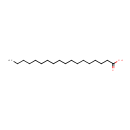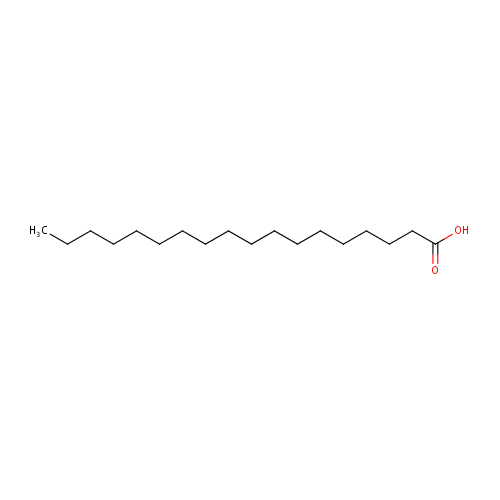| Spectra: |
| Spectrum Type | Description | Splash Key | |
|---|
| GC-MS | GC-MS Spectrum - GC-EI-TOF (Pegasus III TOF-MS system, Leco; GC 6890, Agilent Technologies) (1 TMS) | splash10-0159-1900000000-9cc966384906cd35537d | View in MoNA |
|---|
| GC-MS | GC-MS Spectrum - GC-EI-TOF (Pegasus III TOF-MS system, Leco; GC 6890, Agilent Technologies) | splash10-0159-0900000000-b87a9955374d11966ba6 | View in MoNA |
|---|
| GC-MS | GC-MS Spectrum - GC-EI-TOF (Pegasus III TOF-MS system, Leco; GC 6890, Agilent Technologies) (1 TMS) | splash10-0100-9700000000-979da356343fa0697993 | View in MoNA |
|---|
| GC-MS | GC-MS Spectrum - GC-MS (1 TMS) | splash10-0159-2901000000-16194c704b7abd193647 | View in MoNA |
|---|
| GC-MS | GC-MS Spectrum - GC-MS | Not Available |
|---|
| LC-MS/MS | LC-MS/MS Spectrum - Quattro_QQQ 10V, Negative (Annotated) | splash10-001i-0090000000-1368043827a20e28c172 | View in MoNA |
|---|
| LC-MS/MS | LC-MS/MS Spectrum - Quattro_QQQ 25V, Negative (Annotated) | splash10-001i-0090000000-5c3fa1d38cf3d0a38d74 | View in MoNA |
|---|
| Predicted LC-MS/MS | Predicted LC-MS/MS Spectrum - 10V, Positive | splash10-014r-0090000000-34a309d09cb2def46a19 | View in MoNA |
|---|
| Predicted LC-MS/MS | Predicted LC-MS/MS Spectrum - 20V, Positive | splash10-00kr-4690000000-f68e827f7ebccd80d5bf | View in MoNA |
|---|
| Predicted LC-MS/MS | Predicted LC-MS/MS Spectrum - 40V, Positive | splash10-052f-8920000000-2e865f09d760af582c07 | View in MoNA |
|---|
| Predicted LC-MS/MS | Predicted LC-MS/MS Spectrum - 10V, Positive | splash10-014r-0090000000-34a309d09cb2def46a19 | View in MoNA |
|---|
| Predicted LC-MS/MS | Predicted LC-MS/MS Spectrum - 20V, Positive | splash10-00kr-4690000000-f68e827f7ebccd80d5bf | View in MoNA |
|---|
| Predicted LC-MS/MS | Predicted LC-MS/MS Spectrum - 40V, Positive | splash10-052f-8920000000-2e865f09d760af582c07 | View in MoNA |
|---|
| Predicted LC-MS/MS | Predicted LC-MS/MS Spectrum - 10V, Negative | splash10-001i-0090000000-b3ce35f839a30b41c718 | View in MoNA |
|---|
| Predicted LC-MS/MS | Predicted LC-MS/MS Spectrum - 20V, Negative | splash10-00m0-1090000000-bbb339a3dbe1b9ba0d54 | View in MoNA |
|---|
| Predicted LC-MS/MS | Predicted LC-MS/MS Spectrum - 40V, Negative | splash10-0a4l-9240000000-1b84b49819fa37fce1ae | View in MoNA |
|---|
| Predicted LC-MS/MS | Predicted LC-MS/MS Spectrum - 10V, Negative | splash10-001i-0090000000-b3ce35f839a30b41c718 | View in MoNA |
|---|
| Predicted LC-MS/MS | Predicted LC-MS/MS Spectrum - 20V, Negative | splash10-00m0-1090000000-bbb339a3dbe1b9ba0d54 | View in MoNA |
|---|
| Predicted LC-MS/MS | Predicted LC-MS/MS Spectrum - 40V, Negative | splash10-0a4l-9240000000-1b84b49819fa37fce1ae | View in MoNA |
|---|
| MS | Mass Spectrum (Electron Ionization) | splash10-0c03-9200000000-5dd52f837d56d80fa968 | View in MoNA |
|---|
| 1D NMR | 1H NMR Spectrum | Not Available |
|---|
| 1D NMR | 1H NMR Spectrum | Not Available |
|---|
| 1D NMR | 13C NMR Spectrum | Not Available |
|---|
| 1D NMR | 1H NMR Spectrum | Not Available |
|---|
| 1D NMR | 13C NMR Spectrum | Not Available |
|---|
| 2D NMR | [1H,13C] 2D NMR Spectrum | Not Available |
|---|
|
|---|
| References: |
- Crocker I, Lawson N, Daniels I, Baker P, Fletcher J: Significance of fatty acids in pregnancy-induced immunosuppression. Clin Diagn Lab Immunol. 1999 Jul;6(4):587-93. Pubmed: 10391868
- Daubresse JC: [Atherosclerosis and nutrition] Rev Med Brux. 2000 Sep;21(4):A359-62. Pubmed: 11068494
- Diani F, Cacco M, Molinaroli A, Cerruti G, Meloncelli C, Turinetto A: [Fatty acid composition of the cervical mucus obtained during ovulation and at the term of pregnancy] Minerva Ginecol. 1998 Oct;50(10):405-10. Pubmed: 9866950
- Doran TA, Ford JA, Allen LC, Wong PY, Benzie RJ: Amniotic fluid lecithin/sphingomyelin ratio, palmitic acid, palmitic acid/stearic acid ratio, total cortisol, creatinine, and percentage of lipid-positive cells in assessment of fetal maturity and fetal pulmonary maturity: a comparison. Am J Obstet Gynecol. 1979 Feb 1;133(3):302-7. Pubmed: 433991
- Hoffmann GF, Meier-Augenstein W, Stockler S, Surtees R, Rating D, Nyhan WL: Physiology and pathophysiology of organic acids in cerebrospinal fluid. J Inherit Metab Dis. 1993;16(4):648-69. Pubmed: 8412012
- Hoppu U, Rinne M, Lampi AM, Isolauri E: Breast milk fatty acid composition is associated with development of atopic dermatitis in the infant. J Pediatr Gastroenterol Nutr. 2005 Sep;41(3):335-8. Pubmed: 16131990
- Katsuta Y, Iida T, Inomata S, Denda M: Unsaturated fatty acids induce calcium influx into keratinocytes and cause abnormal differentiation of epidermis. J Invest Dermatol. 2005 May;124(5):1008-13. Pubmed: 15854043
- Kazmierczak SC, Gurachevsky A, Matthes G, Muravsky V: Electron spin resonance spectroscopy of serum albumin: a novel new test for cancer diagnosis and monitoring. Clin Chem. 2006 Nov;52(11):2129-34. Epub 2006 Sep 21. Pubmed: 16990414
- Kelly FD, Sinclair AJ, Mann NJ, Turner AH, Abedin L, Li D: A stearic acid-rich diet improves thrombogenic and atherogenic risk factor profiles in healthy males. Eur J Clin Nutr. 2001 Feb;55(2):88-96. Pubmed: 11305631
- Musial W, Kubis A: Preliminary assessment of alginic acid as a factor buffering triethanolamine interacting with artificial skin sebum. Eur J Pharm Biopharm. 2003 Mar;55(2):237-40. Pubmed: 12637103
- Neoptolemos JP, Thomas BS: Erythrocyte membrane stearic acid: oleic acid ratios in colorectal cancer using tube capillary column gas liquid chromatography. Ann Clin Biochem. 1990 Jan;27 ( Pt 1):38-43. Pubmed: 2310156
- Sanjurjo P, Rodriguez-Alarcon J, Rodriguez-Soriano J: Plasma fatty acid composition during the first week of life following feeding with human milk or formula. Acta Paediatr Scand. 1988 Mar;77(2):202-6. Pubmed: 3354331
- Turpeinen AM, Wubert J, Aro A, Lorenz R, Mutanen M: Similar effects of diets rich in stearic acid or trans-fatty acids on platelet function and endothelial prostacyclin production in humans. Arterioscler Thromb Vasc Biol. 1998 Feb;18(2):316-22. Pubmed: 9484999
- van der Werf, M. J., Overkamp, K. M., Muilwijk, B., Coulier, L., Hankemeier, T. (2007). "Microbial metabolomics: toward a platform with full metabolome coverage." Anal Biochem 370:17-25. Pubmed: 17765195
- Yurtsever D. (2007). Fatty acid methyl ester profiling of Enterococcus and Esherichia coli for microbial source tracking. M.sc. Thesis. Villanova University: U.S.A
|
|---|


